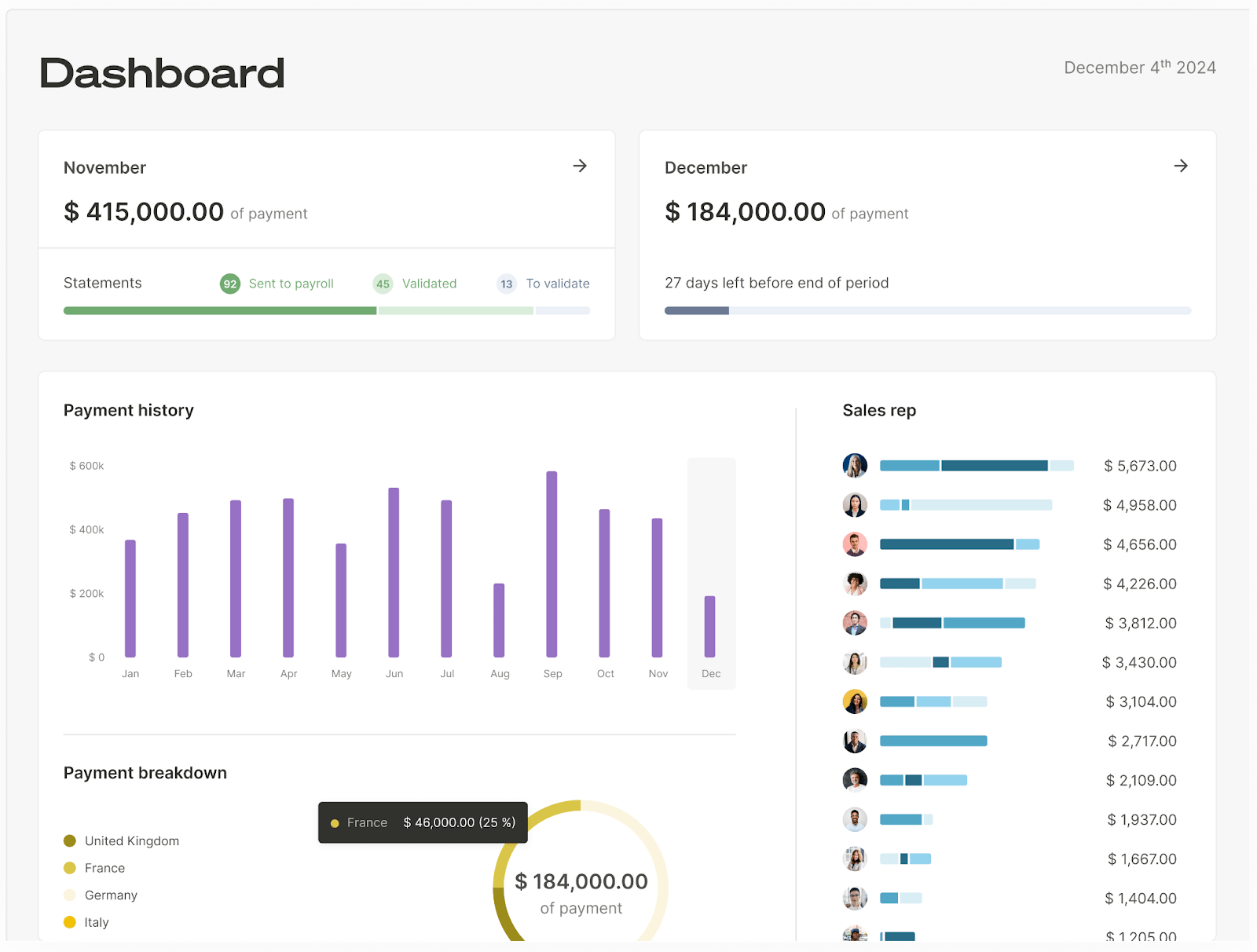Ready to see Qobra in action? Discover and try our platform now for free
Product TourAccording to a Gartner study carried out on 4 continents in different industries, 79% of business decision-makers admit that automation, artificial intelligence and data analysis are major aspects of their success over the next few years.
The days are numbered for the tedious manual tasks of Chief Financial Officers (CFOs) and Chief Revenue Officers (CROs). Automation and artificial intelligence are coming to the rescue to take over these time-consuming tasks. Financial strategists will be able to concentrate on high added-value tasks!
Managing financial data, retrieving data from multiple Excel and Google Sheets spreadsheets, invoicing customers or calculating commission can all take up a considerable amount of finance time.
With the development of automation, no-code and AI, many of these tasks can be automated. Not only does this relieve the people in charge of them, it also reduces the risk of errors and cuts turnaround times!
1. Calculating commissions
Before tackling the topic of commission calculation, it is worth recalling the many stages in a commission management process:
- Configuring a commissioning plan
- Recovering sales reps data from CRM
- Checking commission amounts
- Inter-user communication
- Sharing information
- Management of the commission plan
- Data analysis and processing
- Payment of commissions
Google Sheets and Excel are generally the tools of choice when it comes to calculating sales reps' commission. However, finance departments agree that these tools are not suitable for calculating and managing commissions!
And they are not alone... According to a study on commissions carried out by Qobra and Modjo, 68% of employees are not satisfied with Excel and Google Sheets.
What are the reasons for this frustration?
- Manual calculation of commissions = High error rate = Lack of reliability
- Manual commission calculation = Waste of time
- Commissions not centralized and detailed = Back and forth between stakeholders = Waste of time
- No record of commissions paid = Lack of traceability and auditability
- Inability to budget for commissions = Lack of anticipation and control
Ultimately, depending on the size of the company, these steps can take several days a month, or even several full-time staff. Excel and Google Sheets are therefore obsolete and unsuitable for commission management!
By adopting a platform like Qobra, the company not only saves a considerable amount of time every month, but also improves its sales rep performance.

"It's around 5 to 6 days a month that we save thanks to Qobra compared to Excel."
Maximilien Jooris, Head of Revenue Operations at Agicap
For a CFO or CRO, a commission management platform can be used to :
- Simple implementation or modification of commissioning plans
- Ensuring the reliability of commission amounts
- Exchange information easily with the various stakeholders
- Easily reconstruct changes made to commission systems to remain compliant in the event of an audit
- Create scenarios for provisioning future commissions
- Independently determine the validation process for commissions in line with the hierarchy
- Automate the sending of commissions to payroll
A tool of this kind is a considerable lever for saving time, but also for attracting, motivating and retaining the teams responsible for managing commissions and their beneficiaries.
2. Customer billing
Not so long ago, invoicing was done with a piece of paper, a pen, an envelope and a stamp. Things have changed, and fortunately for corporate finance departments!
Between errors, inaccuracies, non-compliant invoices and the time it takes to process them, invoicing takes up a considerable amount of time. Nevertheless, it is a company's health book. Without good management of customer invoicing, a company risks closing its doors in just a few weeks.
Although sending invoices has now been digitized, this task is still time-consuming and subject to potential human error. Invoicing involves various departments within a company, such as sales reps, customer service and finance. The more people involved, the greater the chance of making a mistake.
CFOs and CROs still have to manually check that customers have paid their invoices correctly. To do this, they need to navigate the company's various accounts. In addition, reminders are also sent by email or telephone, tasks that require time, concentration and productivity. Finally, all the data relating to customer invoices can quickly become scattered. In some companies, the CFO or CRO is therefore obliged to search for and repatriate resources in a single file.
Today, thanks to automation applications and artificial intelligence, high-quality invoicing software has emerged, and its benefits are many:
- Simplified addition of new customers to the customer base with a simple SIRET or company name
- Faster payments
- Automated reminders
- Real-time invoice management
The finance department therefore saves precious time each week, which it can devote to other activities.
💡 Good to know
It is vital to ensure that the various tools required for customer invoicing are properly connected. For example, for the invoicing software to detect customer payments, the company's bank must be linked to it.
From 2024 onwards, regulations on electronic invoicing will require you to choose compliant invoicing software.
Compliant suppliers on the market include Cegid, Sage, Pennylane, Odoo, SAP and NetSuite. It is important to select the right tool for your internal processes.
"Before, a member of staff would process 100 invoices in 1 hour; today, thanks to Pennylane, they can process 200 in 45 minutes."
Franck Laumon, Managing Partner at Dafinity
3. Financial data management
According to a Redbridge survey, more than 2/3 of managers make cash management their priority.
Accounting has long been a tedious business. With manual record-keeping, financial departments had to record everything that went in and out of the company.
When Excel first arrived, it revolutionized the daily lives of CFOs and CROs by simplifying the calculation method and allowing data to be saved instantly. This innovation has simplified working methods and speeded up the execution of teams, with more accurate information and fewer errors.
However, financial data is still entered manually. CFOs and CROs have to enter figures regularly into their tables, and although calculation methods are made easier with Excel, input errors are still common. What's more, this takes up a considerable amount of time for finance teams.
On the other hand, the advent of accounting software has revolutionized the lives of finance teams. Tools such as Pennylane, Sage, QuickBooks, FreshBooks and Axonaut now offer a solution for automating :
- Accounting
- Invoicing
- Payment
- And many other tasks besides
Each of the aforementioned tools has different functionalities that are more or less adapted to the needs and challenges of companies.
"Axonaut helps us to increase productivity by 30%."
Oliver Bellucci Co-founder of Shapy
The main advantage of these automation tools is that they allow you to observe your company's situation in real time. Thanks to AI, the tool is able to detect the next inflows and outflows, so it is possible to understand the figures better and manage your company's finances more effectively. These tools also make it easier to manage working capital requirements, thereby improving the company's overall management and financial health.
It is important to remember that these tools do not replace the CRO or the CFO! They are truly effective assistants, but they do not remove the duty of vigilance with regard to the company's financial data.
4. Payment of taxes
No one thinks of using artificial intelligence or automation to pay their taxes to the State, as it's considered too dangerous and unconscious... However, calculating your tax obligations, remaining fully compliant and preparing your business for the next audit can be made easier by AI and automation!
A CFO or CRO must not only manage the payment of taxes, but also ensure that all deadlines are met throughout the year. Drawing up this tax calendar by hand is tedious and can quickly turn into a time sink. You have to consult a chartered accountant to keep yourself informed, keep up to date and make sure you're always playing by the rules, log on to the various public service platforms to validate remote payments, and so on.
Automation can be used to gather all the information relevant to the company's legal status and send the necessary reminders to the people responsible for paying taxes within the organization. Certain functions can even identify the organization's level of risk and suggest improvements!
Although automating tax payment reminders entails risks, such as incorrectly entering the legal status, which prevents the reminder from being issued and ultimately leads to non-payment of tax, these risks can be controlled!
All the company has to do is check when configuring the tool that all the steps are clearly understood, so as not to miss out on a payment.
Some of the best tools on the market include HelloTax, QuickBooks and Sage, which allow you to calculate taxes and manage returns from start to finish, while keeping control of certain processes.
"Automation is a way of speeding things up, but we still retain control over how the operations are written and how the validation circuit is managed."
Marie-Luce Varlet, Accounts Manager at Royal Hainaut Spa & Resort Hotel
5. Employee payments
A late payment, or forgetting to send a payslip, is a major source of frustration and demotivation for employees.
And yet these errors are understandable, given the complexity of manually managing payslips!
Fortunately, the majority of companies today have digitized this task and now benefit from payroll software. However, not all of them include the same level of automation.
Many organizations still manage this manually:
- Absences
- Holidays
- Expense claims
- Commissions
- Annual interviews
- Monitoring working hours
- Centralising documents
- Payslips
However, software such as PayFit, Lucca and even Cegid include efficient human resource management processes, enabling companies to automate and facilitate the management of these tasks. This saves a considerable amount of time, as there is no need to go back and forth between the various parties involved.
"At Cleor, we draw up around 12,500 payslips a year [...] with a team of three people to look after them, which is why it's so important to have a payroll management solution that's both productive and efficient."
Sébastien Derval, Head of Payroll at Clero (Morellato Group)
To ensure that it works properly, you still need to configure the software's settings to ensure that the process runs smoothly, and to make sure that it works perfectly to avoid any errors.
Beyond the time factor, the economic impact of payroll software is also significant. According to the Total Economic Impact study conducted by PayFit, a company with 10 employees can save €8,700 by using payroll software!
Payroll software provides better management of a company's payroll through the information collected and transmitted by the software, offering advice on the company's recruitment capacity.
The last word...
The era of AI and automation has only just begun. The tools are developing at high speed, giving way to new and particularly relevant functionalities every year!
It is therefore essential to constantly adapt and keep abreast of the latest trends to boost your own productivity as a CFO or CRO.
Many tools have been mentioned in this article. It's worth taking a closer look at the topic and discovering the different solutions they offer, depending on your company and its current processes and tools.
It's essential to move your business towards automation and artificial intelligence - in other words, the solutions of tomorrow!








